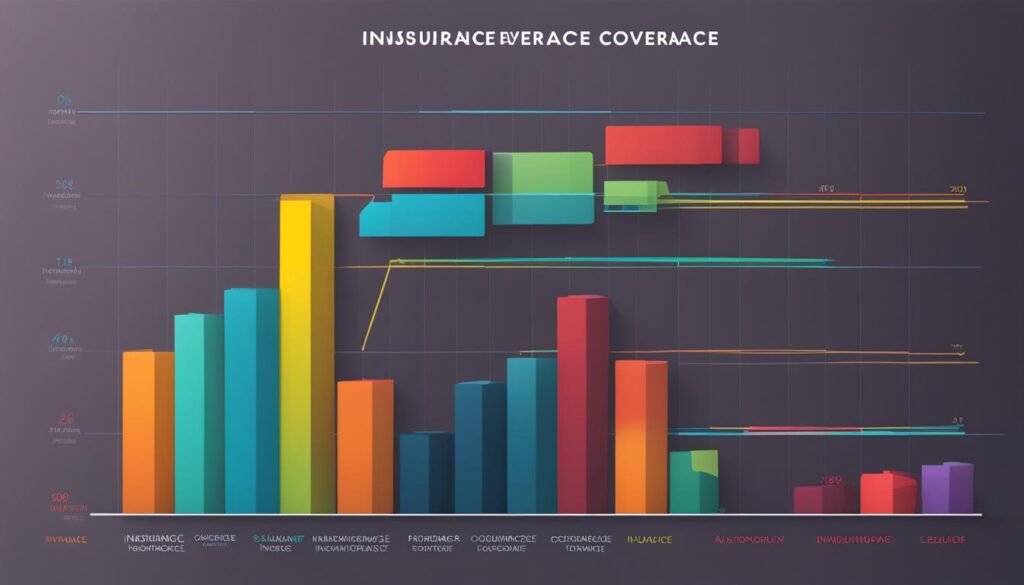Life insurance is a vital component of financial planning as it provides essential protection for your loved ones in the event of your death. With the right premiums insurance policy, you can ensure that your family’s financial security is safeguarded, allowing them to cover funeral expenses, pay off debts, and maintain their day-to-day lifestyle. Understanding your coverage needs and evaluating your insurance policy are important steps in ensuring that you have the appropriate life insurance coverage to protect your family’s financial future.
Key Takeaways: Premiums Insurance
- Life insurance provides financial security for your loved ones.
- Evaluating your coverage needs is crucial in choosing the right insurance policy.
- There are different types of life insurance policies, including term insurance and permanent insurance.
- Factors such as age, health, and lifestyle can affect your insurance premiums.
- Working with a financial advisor can help you determine the optimal coverage for your specific situation.
Do You Need Life Insurance?
Whether or not you need life insurance depends on your financial and family situation. If you have dependents or significant debts that would burden your loved ones in the event of your death, life insurance is essential. On the other hand, if you have no dependents, enough assets to cover your debts, and funeral expenses, life insurance may not be necessary. Evaluating your coverage needs and determining if your policy is sufficient is important to ensure you have the right amount of coverage.
Types of Life Insurance
When it comes to life insurance, there are two main types to consider: term insurance and permanent insurance. Each type offers unique features and benefits tailored to your individual needs and financial goals.
Term Insurance
Term insurance provides coverage for a specific period or term, typically ranging from 10 to 30 years. It offers a death benefit to your beneficiaries if you pass away during the term. Term insurance is often chosen by individuals who have temporary financial obligations, such as a mortgage or the need for income replacement during the working years.
Term insurance is an affordable option and allows you to select a coverage term that aligns with your specific needs. However, it does not build cash value over time.
Permanent Insurance
Permanent insurance, as the name suggests, provides lifelong coverage. Unlike term insurance, it does not have a specific term limit. Permanent insurance includes a cash value component that grows over time, offering additional benefits alongside the death benefit.
With permanent insurance, you have the flexibility to access the accumulated cash value during your lifetime. This can be useful for various purposes, such as supplementing retirement income or covering emergency expenses. The death benefit is paid out to your beneficiaries whenever you pass away, as long as the premiums are up to date.
| Term Insurance | Permanent Insurance |
|---|---|
| Provides coverage for a specific term | Offers lifelong coverage |
| Death benefit paid if you die during the term | Death benefit paid whenever you pass away (as long as premiums are up to date) |
| Affordable option | Includes a cash value component that grows over time |
| Does not build cash value | Flexibility to access cash value during your lifetime |
Choosing between term insurance and permanent insurance depends on your personal circumstances and financial goals. Consider factors such as your coverage needs, budget, and long-term objectives when deciding which type of life insurance is right for you.
Determining Your Coverage Needs

When it comes to life insurance, determining the appropriate coverage amount is crucial. To ensure your loved ones are financially protected, consider the following factors:
- Debt: Take into account any outstanding debts you have, such as mortgages, car loans, or credit card debts.
- Income Replacement: Calculate how much income your dependents would need to maintain their current lifestyle in the event of your passing.
- Beneficiaries: Consider the financial needs of your beneficiaries, such as providing for their education or covering medical expenses.
- Financial Obligations: Evaluate any other financial obligations you want to cover, such as mortgage payments or funeral expenses.
To determine your coverage needs, add up the total amount required to settle your debts, replace your income, and provide for your loved ones. This will give you an estimate of the coverage amount you should aim for.
Working with a financial advisor can be highly beneficial in determining the optimal coverage amount based on your specific situation. They can help you navigate through the complexities of life insurance and ensure you choose a policy that aligns with your financial goals and obligations.
Note: Image shows a representation of coverage needs and is for visual purposes only.
Term Life Insurance vs. Permanent Life Insurance

When it comes to life insurance, understanding the differences between term and permanent policies is crucial in making the right choice for your financial security. Term life insurance offers cost-effective coverage for a specified period, providing flexibility to adapt to your changing needs. On the other hand, permanent life insurance guarantees lifelong protection and builds cash value over time. Let’s compare these two options to help you make an informed decision.
Term Life Insurance
Term life insurance is a popular choice for individuals seeking affordable coverage for a specific term, such as 10, 20, or 30 years. It offers cost-effective premiums and provides a death benefit to your beneficiaries if you pass away during the term. This type of policy is ideal for temporary needs, such as paying off a mortgage or providing income for your dependents while they are financially dependent on you.
Here’s a breakdown of the key features of term life insurance:
| Features | Benefits |
|---|---|
| Cost-effective premiums | Allows you to obtain high coverage amounts at affordable rates |
| Flexible coverage | Gives you the option to choose the term length that aligns with your specific needs |
| No cash value | Focuses solely on providing a death benefit to your beneficiaries |
Permanent Life Insurance
Permanent life insurance, as the name suggests, provides lifelong coverage and offers additional benefits beyond death benefit protection. This type of policy includes a cash value component that grows over time, allowing you to access funds while you’re still alive. Permanent life insurance is suitable for individuals who want lifelong protection and prefer a policy that builds cash value over the years.
Here are the key features of permanent life insurance:
| Features | Benefits |
|---|---|
| Lifelong coverage | Ensures protection for your entire life, as long as premiums are paid |
| Cash value accumulation | Builds a cash value component that can be borrowed or withdrawn during your lifetime |
| Higher premiums | Generally, permanent life insurance requires higher premiums compared to term life insurance |
It’s essential to consider your financial goals, budget, and long-term needs when deciding between term and permanent life insurance. Term life insurance offers an affordable solution for temporary coverage needs, while permanent life insurance provides lifelong protection and the benefits of cash value accumulation.
Image:
Factors Affecting Premiums

The cost of life insurance premiums is determined by various factors that insurance providers take into account. Understanding these factors can help you make informed decisions when choosing a life insurance policy.
Age
Age is a significant factor in determining life insurance premiums. Generally, younger individuals tend to pay lower premiums compared to older individuals. This is because younger individuals are statistically less likely to have significant health issues or face the risk of mortality.
Gender
Gender also plays a role in life insurance premium calculations. Historically, women have been found to have longer life expectancies compared to men. As a result, women often pay lower premiums for the same coverage compared to men.
Health
Your overall health and medical history play a crucial role in determining life insurance premiums. Insurance providers usually evaluate a range of health factors, including pre-existing conditions, lifestyle habits, and family medical history. Individuals with good health and no significant health issues typically receive lower premiums.
Lifestyle Choices
Your lifestyle choices can impact your life insurance premiums. Certain habits, such as smoking or excessive alcohol consumption, can increase the cost of premiums. Insurance providers consider these habits as higher risk factors, which can have a negative impact on your overall health and life expectancy.
Occupation
Your occupation can also affect the cost of life insurance premiums. Riskier professions, such as those involving heavy machinery, hazardous materials, or high-stress environments, may result in higher premiums. Insurance providers take into account the potential occupational hazards that can impact your health and mortality risk.
By understanding the factors that affect life insurance premiums, you can make informed decisions when selecting a policy. Keep in mind that these factors differ between insurance providers, so it’s essential to compare quotes and policies from multiple companies to find the best coverage that suits your needs and budget.
As seen in the image above, age, gender, health, lifestyle choices, and occupation are all factors that can impact your life insurance premiums. It’s important to consider these factors and provide accurate information when applying for coverage to ensure that you receive appropriate pricing and coverage.
Choosing the Right Life Insurance Policy

When selecting a life insurance policy, it’s important to consider several factors that will help you make an informed decision. Think about your liabilities, the financial needs of your loved ones, and the legacy you want to leave behind. By taking these aspects into account, you can choose a policy that provides the necessary coverage and peace of mind.
One important consideration is term length. Determine the duration of coverage that aligns with your financial goals and the needs of your beneficiaries. This will ensure that your loved ones are protected for the desired period, whether it be 10, 20, or 30 years.
To maximize flexibility, consider convertible term insurance. This type of policy allows you to convert your term coverage into a permanent policy without needing to undergo another round of medical underwriting. This can be advantageous if your circumstances change or if you decide you want lifelong protection.
Combining term and permanent insurance policies can create a cost-effective coverage plan. It allows you to have the benefits of term insurance during certain periods when the need is high, and the advantage of permanent insurance to secure and build a financial legacy.
By carefully considering your liabilities, the financial needs of your loved ones, term length, and the option for convertible term insurance, you can choose the right life insurance policy that aligns with your specific circumstances and provides the desired protection.
Life Insurance Coverage Beyond Age 60

Life insurance coverage shouldn’t be overlooked once you reach age 60. In fact, it can continue to provide valuable benefits and financial security for you and your loved ones. Permanent life insurance, in particular, offers lifetime protection and can be a smart choice for individuals in their later years.
With permanent coverage, you can rest assured knowing that your life insurance policy will remain in effect as long as you continue to pay the premiums. This ensures that your loved ones will receive a death benefit whenever you pass away, providing them with financial support and peace of mind. Permanent coverage is especially beneficial if you have dependents or want to leave a legacy and pass on an inheritance.
One of the advantages of permanent life insurance is that it can also serve as a source of retirement savings. Over time, the policy accumulates a cash value component that grows tax-deferred. You can access this cash value through policy loans or withdrawals, which can be used to supplement your retirement income or cover unexpected expenses. It’s important to consult with a financial advisor to fully understand the tax consequences and potential impact on your policy before making any withdrawals.
Legacy planning is another important aspect to consider when using permanent life insurance coverage beyond age 60. You can designate beneficiaries who will receive the death benefit and create a lasting impact for your loved ones or favorite charitable organizations. This allows you to leave a positive financial legacy that helps support your family or contribute to causes that are important to you.
In summary, life insurance coverage remains valuable beyond age 60. Permanent life insurance offers lifetime protection, serves as a potential source of retirement savings, and provides a means for legacy planning. While it’s important to consider your individual needs and consult with a financial advisor, obtaining permanent life insurance can ensure ongoing financial security and support for your loved ones even after you reach retirement age.
Accessing Life Insurance Cash Value

Permanent life insurance policies offer a unique feature known as the cash value component, which grows over time. This cash value can serve as a valuable financial resource and can be accessed through policy loans or withdrawals. However, it’s essential to consider the potential tax consequences and the impact on your policy’s coverage.
Policy Loans: One way to access the cash value is by taking a policy loan. By borrowing against the cash value, policyholders can access funds without the need for a credit check or collateral. Policy loans typically have lower interest rates compared to traditional loans, making them an attractive option for emergency expenses, debt consolidation, or any other financial needs.
Tax Consequences: While policy loans are generally tax-free, it’s important to note that the borrowed amount may be subject to interest charges. If the policy lapses or is surrendered, any outstanding loans may be considered taxable income, which can have significant financial implications. Consulting with a tax advisor or financial professional is crucial to understand the tax implications of borrowing from your life insurance policy.
Emergency Fund: It’s important to treat the cash value as an Emergency Fund and consider it a last resort asset. The primary purpose of life insurance is to provide financial protection for your loved ones in the event of your passing. Withdrawing or borrowing too much from the cash value can jeopardize the policy’s coverage and potentially leave your beneficiaries without the necessary financial support.
When considering accessing the cash value, it’s essential to evaluate your financial situation carefully and determine the best course of action. If you’re unsure about the potential consequences or how it aligns with your overall financial goals, consulting with a financial advisor can provide valuable guidance.
Cash Value Illustration:
| Policy Year | Cash Value |
|---|---|
| 1 | $10,000 |
| 5 | $12,500 |
| 10 | $20,000 |
| 15 | $30,000 |
| 20 | $45,000 |
When considering whole life insurance or other insurance policies, it’s essential to compare insurance options and understand the factors that influence the amount you pay for an insurance policy. Various insurance companies offer different types of coverage, and the premiums you pay depend on a variety of factors such as your health, life expectancy, insurance scores, and insurance history.
Auto insurance rates, homeowners insurance premiums, and car insurance premiums are all influenced by individual insurance details, and choosing a higher deductible may help you pay lower premiums. Understanding insurance laws and regulations is crucial, as insurance companies may use different methods to determine premiums, and state insurance regulators play a role in ensuring fairness.
Whether it’s annual premiums, deductibles, or different types of premiums, knowing how insurance premiums are calculated and what affects your premium is key to making informed decisions when buying an insurance policy. By comparing insurance costs, premiums, and coverage from different companies, you can find the best insurance for your needs, taking into account various factors and types of premiums that suit your individual circumstances.
Also Read : Demystifying State Auto Insurance: What You Need To Know For Smart Coverage!
Conclusion
Life insurance plays a vital role in achieving financial security and safeguarding the well-being of your loved ones. By assessing your coverage needs, exploring term and permanent insurance options, and consulting with a financial advisor, you can make informed decisions and select the ideal life insurance policy for your specific circumstances. It is important to regularly review and adjust your coverage as your situation changes to ensure continuous financial protection for your family.
When it comes to protecting your financial future, life insurance is an essential tool that provides peace of mind. By understanding your coverage needs and evaluating the different types of life insurance, such as term and permanent insurance, you can choose a policy that aligns with your goals and priorities. Whether you need coverage for a specific period or lifelong protection with a cash value component, there is a life insurance solution available to meet your requirements.
Working with a financial advisor can provide valuable guidance and help you navigate the complexities of life insurance. They can assist you in determining the optimal coverage amount, considering factors such as outstanding debts, income replacement, and financial obligations. With their expertise, you can make confident decisions that will protect your loved ones and provide the financial security they deserve.
Remember, life insurance is not a one-time decision. It is important to regularly reevaluate your coverage to ensure it aligns with your evolving needs. As your circumstances change, such as starting a family, purchasing a home, or entering retirement, your life insurance requirements may also change. By staying proactive and adjusting your coverage accordingly, you can maintain the level of financial protection that is necessary for you and your loved ones.
FAQs
Q: What is an insurance premium?
A: An insurance premium is the amount an individual or business must pay for an insurance policy. It is determined by the insurer based on various factors.
Q: How are insurance premiums calculated?
A: Insurance premiums are calculated based on factors such as the type of insurance, the coverage amount, the insured person’s risk profile, and the frequency of claims in the area.
Q: How can I lower my insurance premiums?
A: You can lower your insurance premiums by maintaining a good credit history, choosing a higher deductible, and shopping around to find the best rates from different insurers.
Q: What are car insurance premiums?
A: Car insurance premiums are the regular payments made to the insurance company to maintain an auto insurance policy. The amount is based on the type of coverage and the individual’s risk factors.
Q: Why are some insurance premiums higher than others?
A: Insurance premiums can be higher due to factors such as the individual’s risk profile, the type of coverage needed, and the frequency of claims in the area where the individual lives or operates.
Q: What is a deductible in insurance?
A: A deductible is the amount of money an individual must pay out of pocket before the insurance company begins to pay for covered expenses. Choosing a higher deductible can lower insurance premiums.
Q: Do I have to pay insurance premiums monthly or yearly?
A: You can pay insurance premiums monthly, quarterly, or yearly, depending on the specific terms of your insurance plan and the policies of the insurance company.
Q: How do I determine the amount of my insurance premium?
A: The amount of your insurance premium is determined by the insurance company based on factors such as the type of coverage, your risk profile, and the frequency of claims in your area.
Q: What should I consider when choosing insurance premiums?
A: When choosing insurance premiums, it’s important to consider the level of coverage needed, the deductible amount, the reputation of the insurer, and the overall cost of the premiums.
Q: Can I use the premiums from one insurance policy to cover another?
A: No, the premiums paid for a specific insurance policy are used to cover expenses and claims under that policy only. They cannot be used to cover expenses under a different insurance policy.





